Abstract
Monitoring of ventricular function by central venous (CVP) and pulmonary wedge pressures (PCW) was compared with ejection fraction and end-diastolic volume (gated pool scan) in patients resuscitated from hypovolemic and septic shock. Sixteen patients were studied within 24 hours of resuscitation and all showed depressed right ventricular ejection (RVEF) and/or an increased end-diastolic volume (RVEDVI). Group I (eight patients, hypovolemia and sepsis) had low RVEF (mean, 0.30), high RVEDVI (mean 129.2 ml/m2), and nearly normal left ventricular function (LVEF 0.63 and LVEDVI 63.6 ml/m2), compared to angiographic normals (RVEF 0.52, RVEDVI 55.8 ml/m2; nL LVEF 0.59, LVEDVI 52.3 ml/m2). Group II (3 patients, all septic) had better RVEF (mean, 0.54) but high RVEDVI (mean, 121.1 ml/m2) with normal LVEF (mean, 0.67) and high LVEDVI (mean LVEDVI 107.2 ml/m2). Group III consisted of five patients (hypovolemia and sepsis) who had biventricular depression (RVEF 0.25 and LVEF 0.29) and elevated EDVI. The mortality rate for group I (25%) was significantly less than for groups II and III (100% and 80%, respectively), and could be correlated with failure to improve RV function. Follow-up studies in ten patients showed improvement in seven which correlated with increased RVEF and reduced RVEDVI. Comparing survivors to non-survivors showed no predictability on the basis of initial studies but a significantly larger RVEDVI and RV stroke work index in non-survivors' follow-up studies. No correlation could be made with left ventricular performance, and there were no correlations between PCWP and LVEDVI or CVP and RVEDVI. A significant negative correlation was seen between RVEF and pulmonary vascular resistance (r = -0.34, p less than 0.05). Both LVEDVI and RVEDVI were correlated significantly with cardiac index and with each other. RV dysfunction occurs after resuscitation of hypovolemia and sepsis without reliable alteration in filling pressure and is likely related to myocardial ischemia as well as increased pulmonary vascular resistance. Survival seems to depend on improvement in RV performance, which can be measured at the bedside by cardiac scintigraphy.
Full text
PDF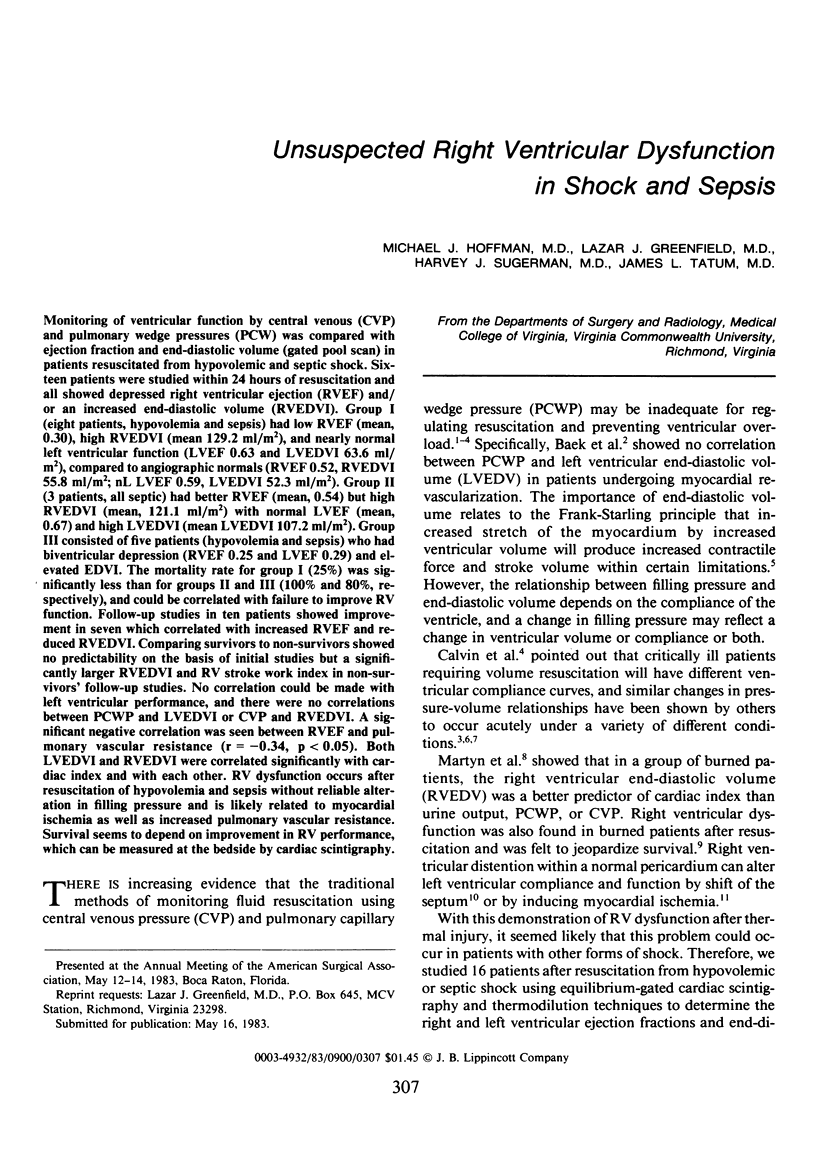
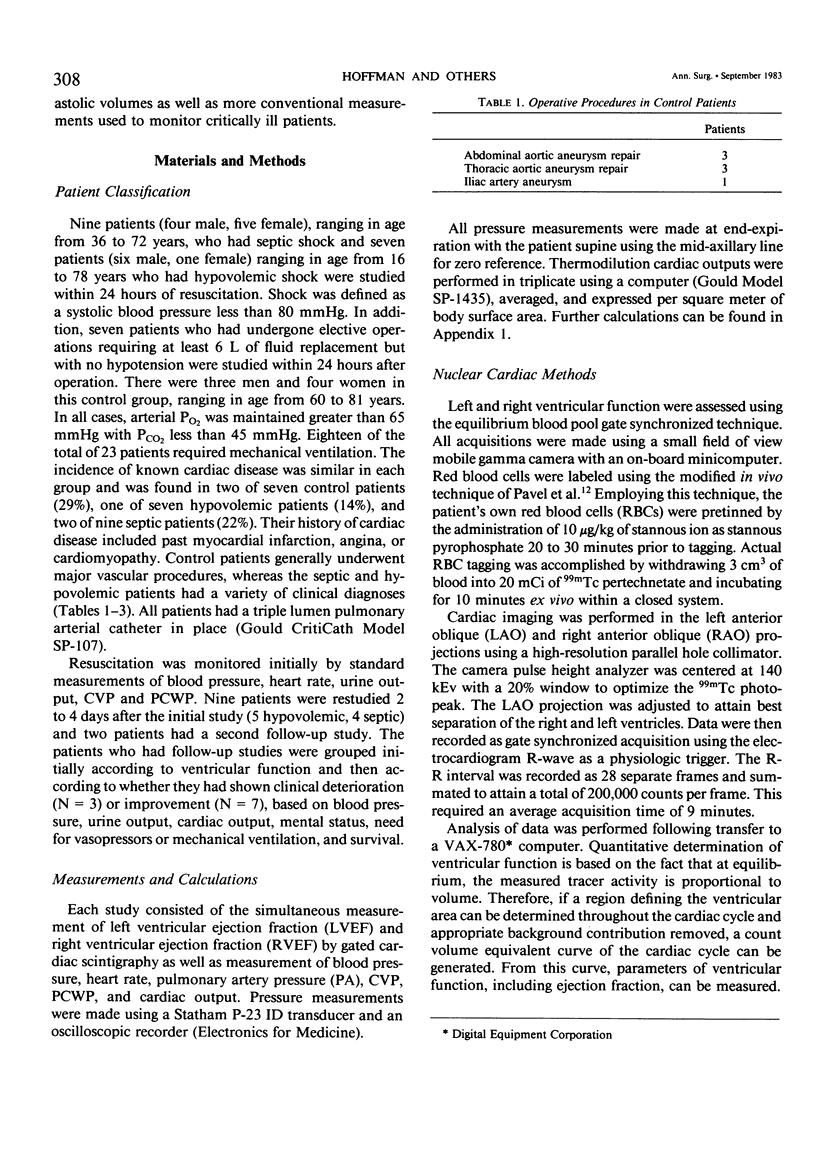
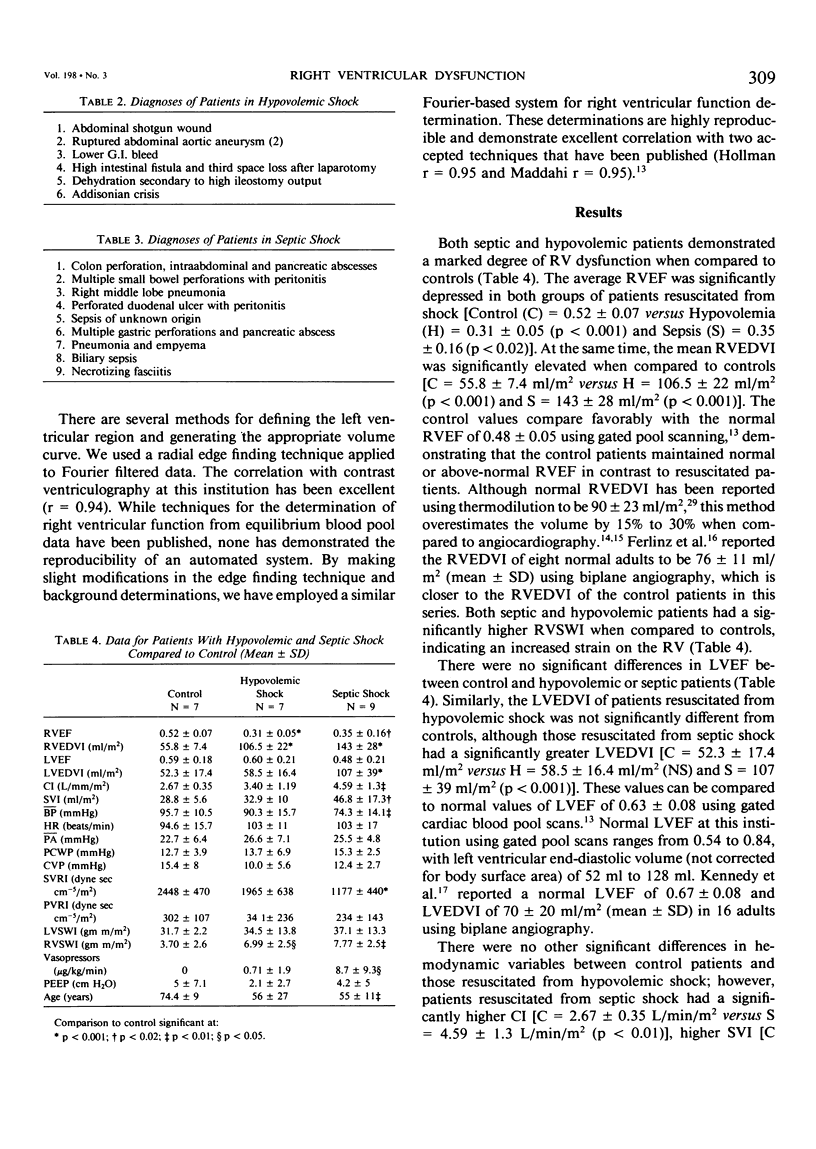
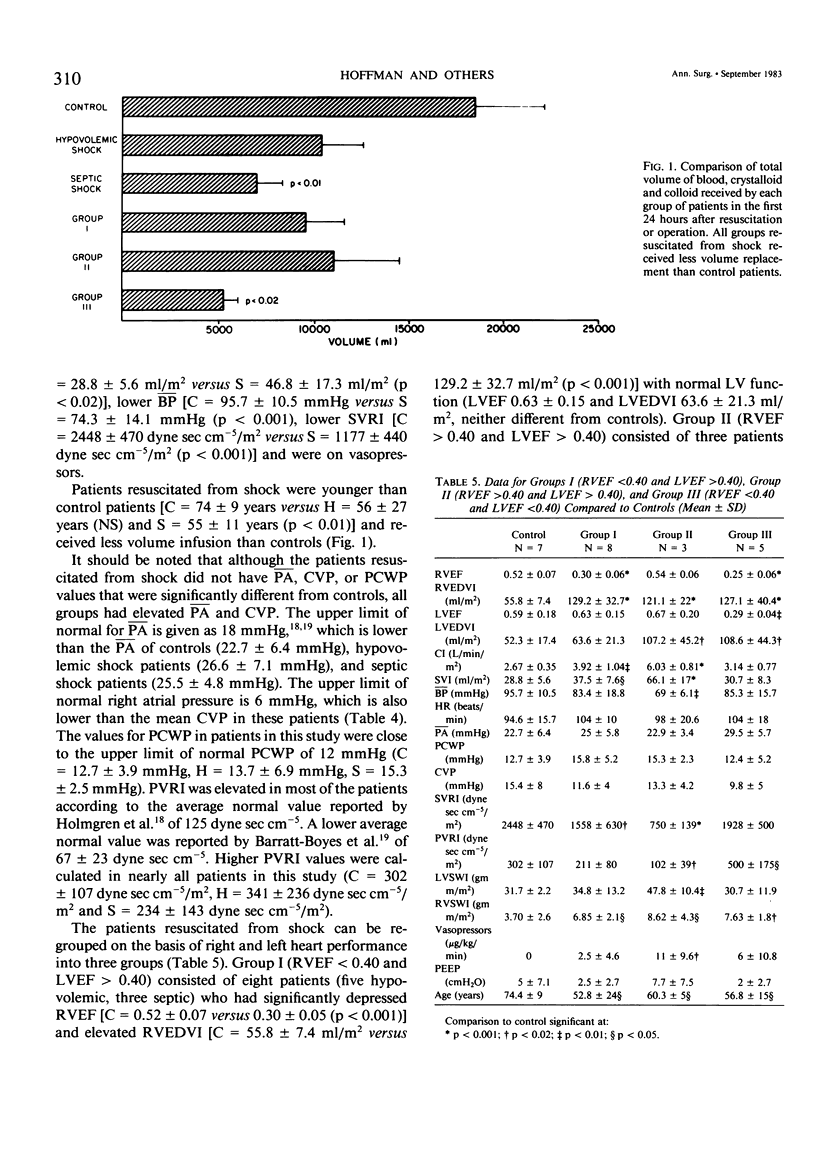


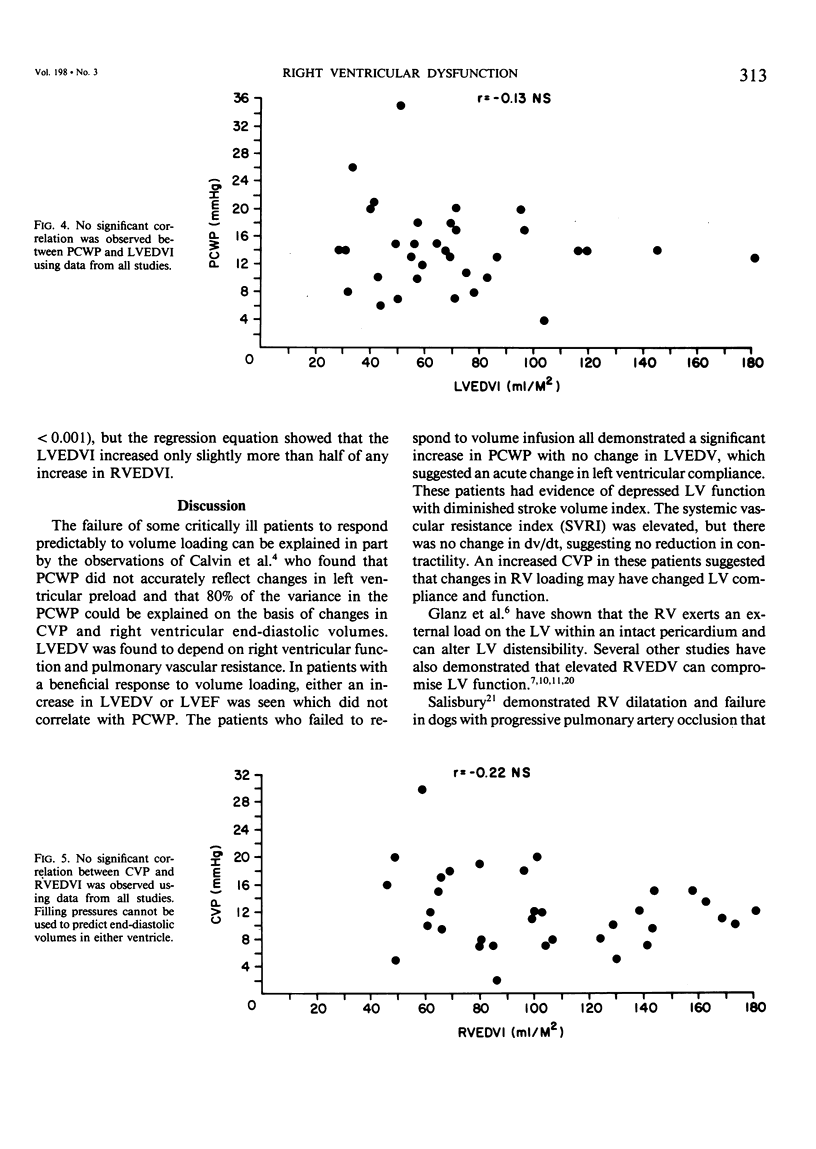

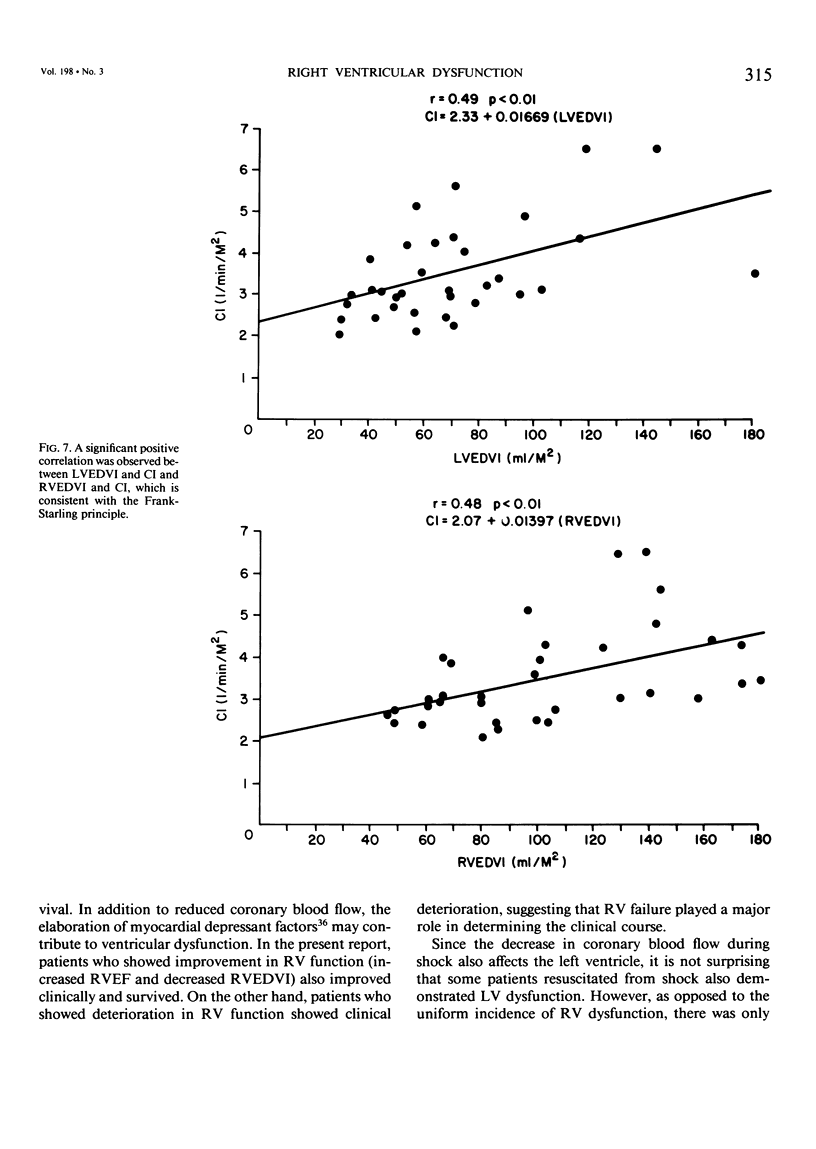
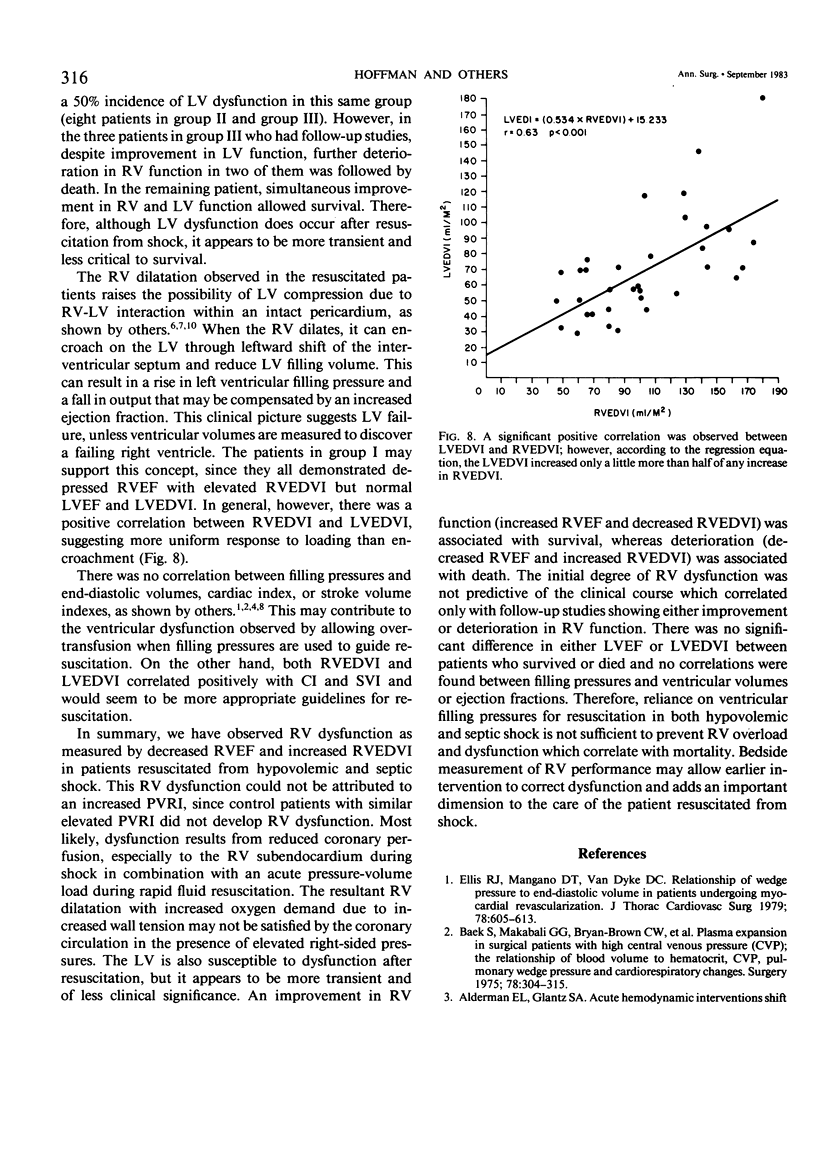
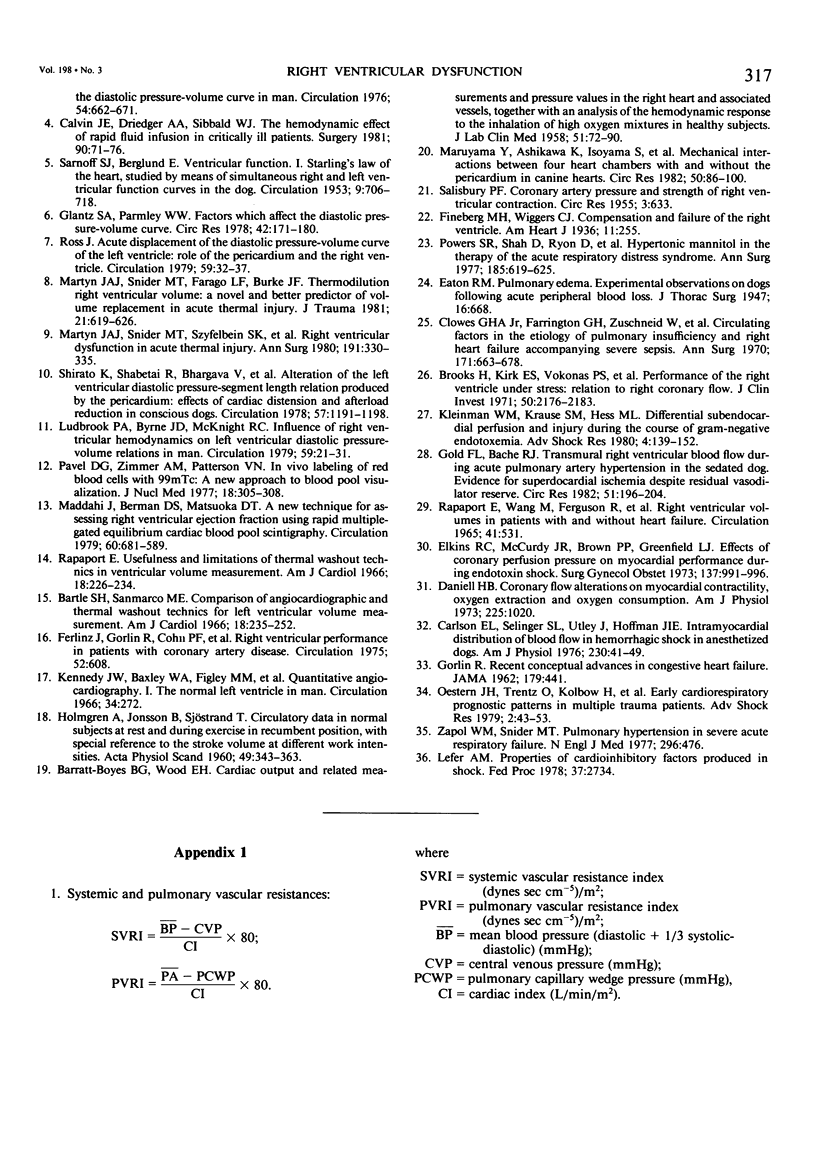
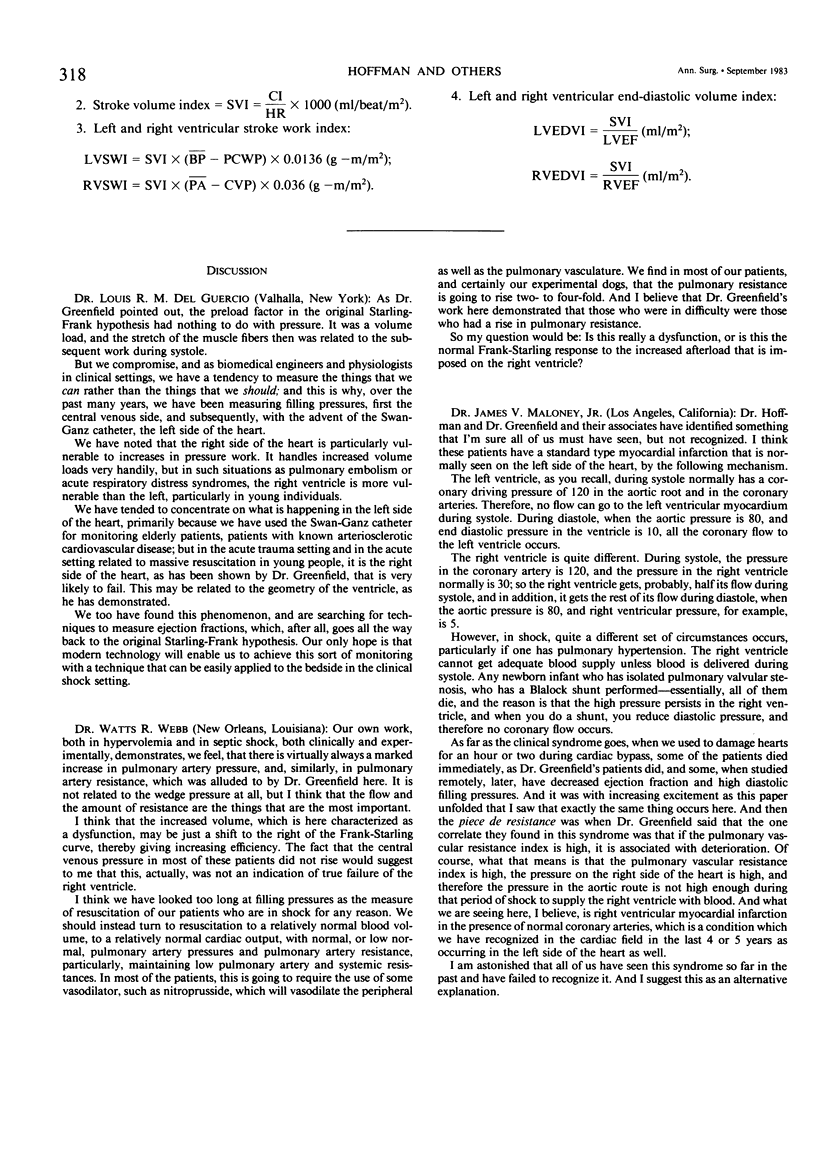
Selected References
These references are in PubMed. This may not be the complete list of references from this article.
- Alderman E. L., Glantz S. A. Acute hemodynamic interventions shift the diastolic pressure-volume curve in man. Circulation. 1976 Oct;54(4):662–671. doi: 10.1161/01.cir.54.4.662. [DOI] [PubMed] [Google Scholar]
- BARRATT-BOYES B. G., WOOD E. H. Cardiac output and related measurements and pressure values in the right heart and associated vessels, together with an analysis of the hemo-dynamic response to the inhalation of high oxygen mixtures in healthy subjects. J Lab Clin Med. 1958 Jan;51(1):72–90. [PubMed] [Google Scholar]
- Baek S. M., Makabali G. G., Bryan-Brown C. W., Kusek J. M., Shoemaker W. C. Plasma expansion in surgical patients with high central venous pressure (CVP); the relationship of blood volume to hematocrit, CVP, pulmonary wedge pressure, and cardiorespiratory changes. Surgery. 1975 Sep;78(3):304–315. [PubMed] [Google Scholar]
- Bartle S. H., Sanmarco M. E. Comparison of angiocardiographic and thermal washout technics for left ventricular volume measurement. Am J Cardiol. 1966 Aug;18(2):235–252. doi: 10.1016/0002-9149(66)90036-1. [DOI] [PubMed] [Google Scholar]
- Brooks H., Kirk E. S., Vokonas P. S., Urschel C. W., Sonnenblick E. H. Performance of the right ventricle under stress: relation to right coronary flow. J Clin Invest. 1971 Oct;50(10):2176–2183. doi: 10.1172/JCI106712. [DOI] [PMC free article] [PubMed] [Google Scholar]
- Calvin J. E., Driedger A. A., Sibbald W. J. The hemodynamic effect of rapid fluid infusion in critically ill patients. Surgery. 1981 Jul;90(1):61–76. [PubMed] [Google Scholar]
- Carlson E. L., Selinger S. L., Utley J., Hoffman J. I. Intramyocardial distribution of blood flow in hemorrhagic shock in anesthetized dogs. Am J Physiol. 1976 Jan;230(1):41–49. doi: 10.1152/ajplegacy.1976.230.1.41. [DOI] [PubMed] [Google Scholar]
- Clowes G. H., Jr, Farrington G. H., Zuschneid W., Cossette G. R., Saravis C. Circulating factors in the etiology of pulmonary insufficiency and right heart failure accompanying severe sepsis (peritonitis). Ann Surg. 1970 May;171(5):663–678. doi: 10.1097/00000658-197005000-00005. [DOI] [PMC free article] [PubMed] [Google Scholar]
- Daniell H. B. Coronary flow alterations on myocardial contractility, oxygen extraction, and oxygen consumption. Am J Physiol. 1973 Nov;225(5):1020–1025. doi: 10.1152/ajplegacy.1973.225.5.1020. [DOI] [PubMed] [Google Scholar]
- Elkins R. C., McCurdy J. R., Brown P. P., Greenfield L. J. Effects of coronary perfusion pressure on myocardial performance during endotoxin shock. Surg Gynecol Obstet. 1973 Dec;137(6):991–996. [PubMed] [Google Scholar]
- Ellis R. J., Mangano D. T., VanDyke D. C. Relationship of wedge pressure to end-diastolic volume in patients undergoing myocardial revascularization. J Thorac Cardiovasc Surg. 1979 Oct;78(4):605–613. [PubMed] [Google Scholar]
- Ferlinz J., Gorlin R., Cohn P. F., Herman M. V. Right ventricular performance in patients with coronary artery disease. Circulation. 1975 Oct;52(4):608–615. doi: 10.1161/01.cir.52.4.608. [DOI] [PubMed] [Google Scholar]
- GORLIN R. Recent conceptual advances in congestive heart failure. JAMA. 1962 Feb 10;179:441–449. [PubMed] [Google Scholar]
- Glantz S. A., Parmley W. W. Factors which affect the diastolic pressure-volume curve. Circ Res. 1978 Feb;42(2):171–180. doi: 10.1161/01.res.42.2.171. [DOI] [PubMed] [Google Scholar]
- Gold F. L., Bache R. J. Transmural right ventricular blood flow during acute pulmonary artery hypertension in the sedated dog. Evidence for subendocardial ischemia despite residual vasodilator reserve. Circ Res. 1982 Aug;51(2):196–204. doi: 10.1161/01.res.51.2.196. [DOI] [PubMed] [Google Scholar]
- HOLMGREN A., JONSSON B., SJOSTRAND T. Circulatory data in normal subjects at rest and during exercise in recumbent position, with special reference to the stroke volume at different work intensities. Acta Physiol Scand. 1960 Aug 25;49:343–363. doi: 10.1111/j.1748-1716.1960.tb01957.x. [DOI] [PubMed] [Google Scholar]
- Kennedy J. W., Baxley W. A., Figley M. M., Dodge H. T., Blackmon J. R. Quantitative angiocardiography. I. The normal left ventricle in man. Circulation. 1966 Aug;34(2):272–278. doi: 10.1161/01.cir.34.2.272. [DOI] [PubMed] [Google Scholar]
- Kleinman W. M., Krause S. M., Hess M. L. Differential subendocardial perfusion and injury during the course of gram-negative endotoxemia. Adv Shock Res. 1980;4:139–152. [PubMed] [Google Scholar]
- Lefer A. M. Properties of cardioinhibitory factors produced in shock. Fed Proc. 1978 Nov;37(13):2734–2740. [PubMed] [Google Scholar]
- Ludbrook P. A., Byrne J. D., McKnight R. C. Influence of right ventricular hemodynamics on left ventricular diastolic pressure-volume relations in man. Circulation. 1979 Jan;59(1):21–31. doi: 10.1161/01.cir.59.1.21. [DOI] [PubMed] [Google Scholar]
- Maddahi J., Berman D. S., Matsuoka D. T., Waxman A. D., Stankus K. E., Forrester J. S., Swan H. J. A new technique for assessing right ventricular ejection fraction using rapid multiple-gated equilibrium cardiac blood pool scintigraphy. Description, validation and findings in chronic coronary artery disease. Circulation. 1979 Sep;60(3):581–589. doi: 10.1161/01.cir.60.3.581. [DOI] [PubMed] [Google Scholar]
- Martyn J. A., Snider M. T., Farago L. F., Burke J. F. Thermodilution right ventricular volume: a novel and better predictor of volume replacement in acute thermal injury. J Trauma. 1981 Aug;21(8):619–626. [PubMed] [Google Scholar]
- Martyn J. A., Snider M. T., Szyfelbein S. K., Burke J. F., Laver M. B. Right ventricular dysfunction in acute thermal injury. Ann Surg. 1980 Mar;191(3):330–335. doi: 10.1097/00000658-198003000-00012. [DOI] [PMC free article] [PubMed] [Google Scholar]
- Maruyama Y., Ashikawa K., Isoyama S., Kanatsuka H., Ino-Oka E., Takishima T. Mechanical interactions between four heart chambers with and without the pericardium in canine hearts. Circ Res. 1982 Jan;50(1):86–100. doi: 10.1161/01.res.50.1.86. [DOI] [PubMed] [Google Scholar]
- Oestern H. J., Trentz O., Kolbow H., Wannske M., Hempelmann G., Trentz O. A. Early cardiorespiratory prognostic patterns in multiple trauma patients. Adv Shock Res. 1979;2:43–53. [PubMed] [Google Scholar]
- Pavel D. G., Zimmer M., Patterson V. N. In vivo labeling of red blood cells with 99mTc: a new approach to blood pool visualization. J Nucl Med. 1977 Mar;18(3):305–308. [PubMed] [Google Scholar]
- Powers S. R., Jr, Shah D., Ryon D., Newell J., Ralph C., Scovill W., Dutton R. Hypertonic mannitol in the therapy of the acute respiratory distress syndrome. Ann Surg. 1977 Jun;185(6):619–625. doi: 10.1097/00000658-197706000-00002. [DOI] [PMC free article] [PubMed] [Google Scholar]
- RAPAPORT E., WONG M., FERGUSON R. E., BERNSTEIN P., WIEGAND B. D. RIGHT VENTRICULAR VOLUMES IN PATIENTS WITH AND WITHOUT HEART FAILURE. Circulation. 1965 Apr;31:531–541. doi: 10.1161/01.cir.31.4.531. [DOI] [PubMed] [Google Scholar]
- Rapaport E. Usefulness and limitations of thermal washout technics in ventricular volume measurement. Am J Cardiol. 1966 Aug;18(2):228–234. doi: 10.1016/0002-9149(66)90035-x. [DOI] [PubMed] [Google Scholar]
- Ross J., Jr Acute displacement of the diastolic pressure-volume curve of the left ventricle: role of the pericardium and the right ventricle. Circulation. 1979 Jan;59(1):32–37. doi: 10.1161/01.cir.59.1.32. [DOI] [PubMed] [Google Scholar]
- SALISBURY P. F. Coronary artery pressure and strength of right ventricular contraction. Circ Res. 1955 Nov;3(6):633–638. doi: 10.1161/01.res.3.6.633. [DOI] [PubMed] [Google Scholar]
- SARNOFF S. J., BERGLUND E. Ventricular function. I. Starling's law of the heart studied by means of simultaneous right and left ventricular function curves in the dog. Circulation. 1954 May;9(5):706–718. doi: 10.1161/01.cir.9.5.706. [DOI] [PubMed] [Google Scholar]
- Shirato K., Shabetai R., Bhargava V., Franklin D., Ross J., Jr Alteration of the left ventricular diastolic pressure-segment length relation produced by the pericardium. Effects of cardiac distension and afterload reduction in conscious dogs. Circulation. 1978 Jun;57(6):1191–1198. doi: 10.1161/01.cir.57.6.1191. [DOI] [PubMed] [Google Scholar]
- Zapol W. M., Snider M. T. Pulmonary hypertension in severe acute respiratory failure. N Engl J Med. 1977 Mar 3;296(9):476–480. doi: 10.1056/NEJM197703032960903. [DOI] [PubMed] [Google Scholar]


